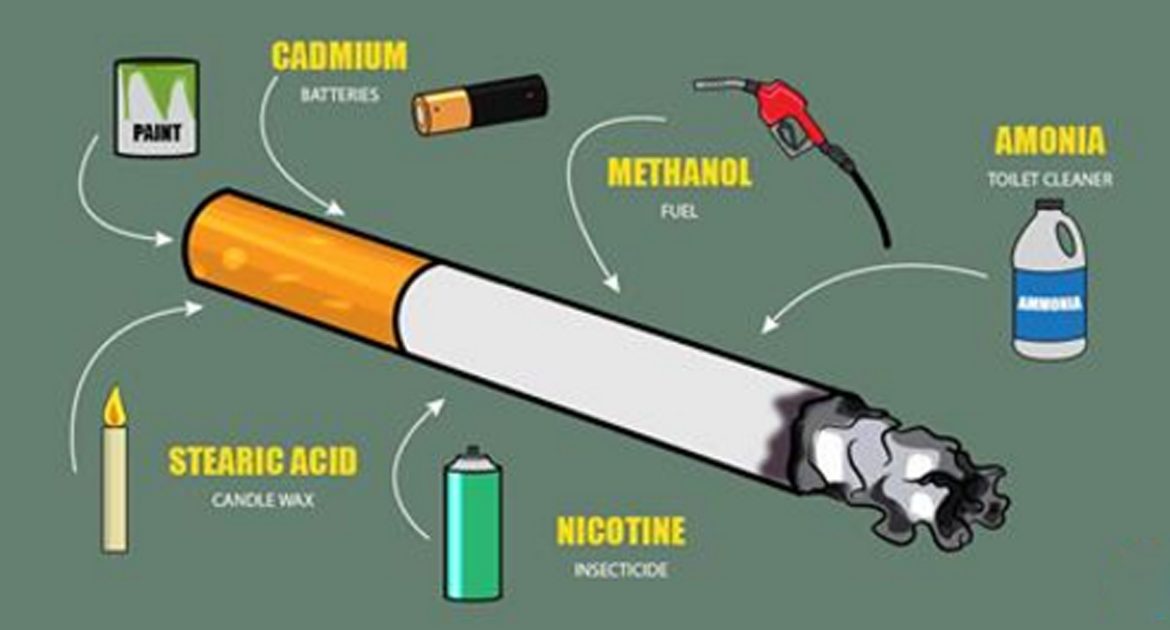Tobacco and smoking are considered one of the highest causes of cancer, to the point that a warning to quit smoking is printed on the side of every cigarette carton sold. However, tobacco isn’t the only dangerous substances inhaled when smoking; listed are some of the chemicals found in cigarettes and tobacco smoke and their effects on the human body.

Mercury
Mercury is a neurotoxin that can cause extreme amounts of damage to the body, according to the Environmental Protection Agency. Studies have shown the chemical can cause behavioral changes, headaches, hypertension and changes to cardiovascular function at low exposure.

Carbon Monoxide
This chemical is odorless, colorless, and can have serious effects to humans exposed for long periods of time. Because it displaces the oxygen that should be inhaled, CO poisoning over an extended period of time can lead to heart disease, according to the Centers for Disease Control and Prevention. Side effects of Carbon Monoxide include weakness, dizziness, shortness of breath and blurred vision.
Hydrogen Cyanide
A highly dangerous component, Hydrogen cyanide is characterized as a chemical asphyxiant, meaning that as a gas or vapor it can prevent oxygen from reaching tissues and cause unconsciousness or death, according to the Agency for Toxic Substances and Disease Registry. The chemical is highly toxic and poisons the cardiovascular and respiratory systems, then affecting the metabolism, vision, and brain.
Formaldehyde
A colorless, flammable chemical, formaldehyde is found naturally as part of the metabolic process and is used for a variety of household products. However, when it makes up more than .1 ppm of air levels, the chemical can cause short-term health effects that include watery eyes, wheezing, and burning eyes and throat, according to the National Cancer Institute. In long term effects, scientists have labeled it as a probable carcinogen, as some studies have found that people repeatedly exposed to it have had higher cases of nose and throat cancer.
Lead
Share Source: By Carsten Niehaus — taken myself, Public Domain
Lead poisoning can occur slowly, and the symptoms alone are not usually immediately attributed to the metal. Side effects that a person may experience include tiredness, irritation, loss of appetite, and distractedness, according to the CDC, and may also find themselves at risk for high blood pressure and kidney disease. There is no safe amount of lead to have in the body, and at this point, the International Agency for Research on Cancer has determined that lead is a probable cause of cancer.
Ammonia
While common in household and industrial products, ammonia can have serious consequences when inhaled. According to the New York State Department of Health, the chemical is corrosive and can destroy airways, causing respiratory distress and/ or failure. At low exposure, it causes olfactory fatigue, as well as coughing, chest pain, and burning sensations in the throat and nose.
Potassium Citrate
Although this chemical can be used to help rid the kidneys of acidic urine, it is only prescribed if there is already a serious pre-existing problem for which it is used as treatment. The side effects of Potassium citrate range from nausea and stomach pain to more serious effects, including dizziness, fast heartbeat, and muscle weakness, according to WebMD.

If you have a smoking habit, or smoke occasionally, consider quitting today and make some lifestyle changes to replace bad habits. If one of your family members is suffering from cigarette addiction, please share this article with them today. It’s never too late to make a change for the better. Try using a toothpick to curb the oral fixation and mints or gum. Not only will this ease your craving, but your breath will smell better too. Your loved ones will thank you.
Please Liked Video this with your friends and family.






